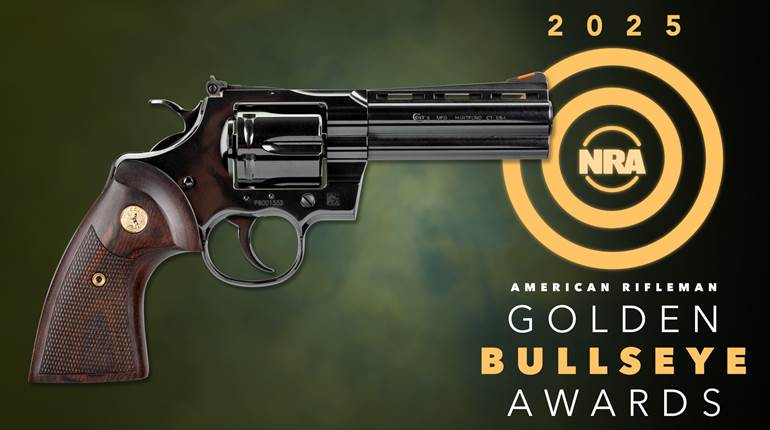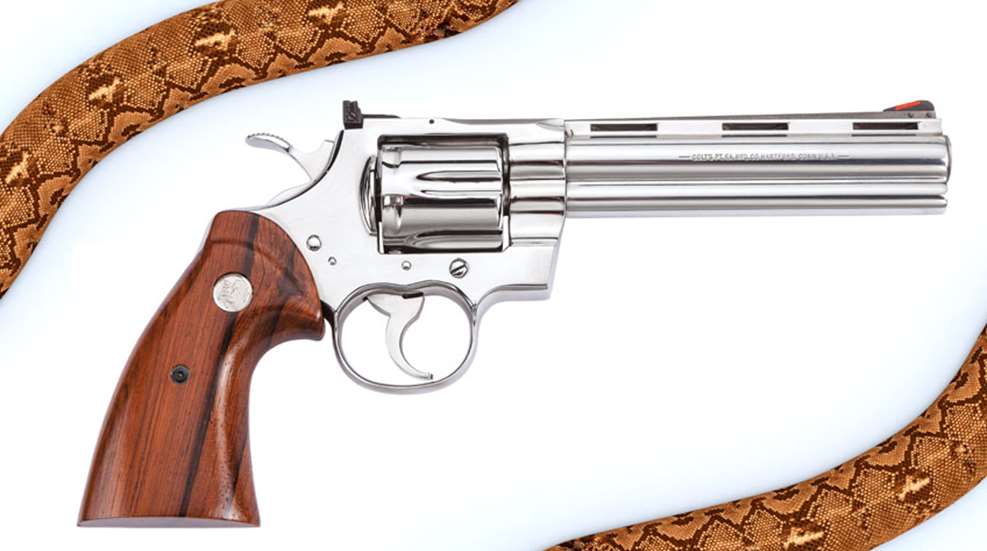
Double Diamond Edition Python Serial No. DD001
Originally paired with an Officer's ACP as part of a cased set, this .357 Mag. Double Diamond Edition Python has a bright stainless finish, a 6" barrel and is fitted with smooth rosewood target-style stocks with nickel-finished 150th Anniversary Rampant Colt medallions.
In June 1955, Colt’s Mfg. Co.’s new masterpiece, the Python double-action revolver, was first shipped from the Hartford, Conn., factory, beginning a half-century of continuous production. Colt’s factory superintendent, Adalbert (Al) Gunther, was heavily involved in the design of what was to become the company’s flagship double-action revolver. It started in 1953 when Bill Henry, Colt’s head salesman, came to Gunther with the idea for a new precision target revolver. Colt had no budget for experimental guns at the time, so the prototype was made from existing parts and from raw steel, which was machined and welded as needed.
The original prototype had a barrel length of 4 5⁄8", and the barrel rib was solid. That first gun took almost a month to complete, with some of Colt’s top foremen—Andy Perkins, Walter Sowinski and George Cramer—involved with the project. The name “Python” came about as the result of a company contest, and it is believed that Philip Schwartz, one of Colt’s vice presidents, came up with the winning name.
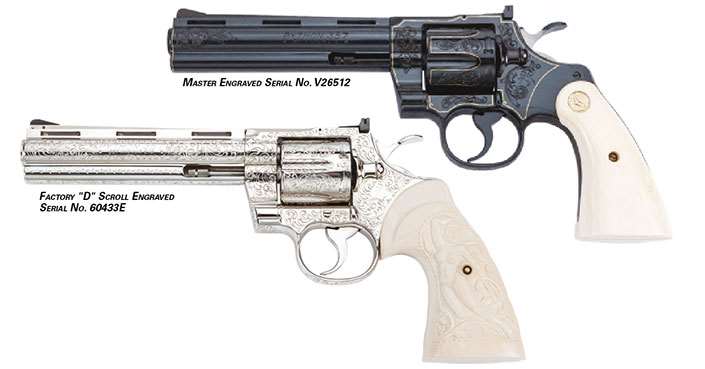
Colt Python Serial No. 1, which was hand-built by Colt Master Gunsmith Alfred DeJohn, resides in the Wadsworth Atheneum in Hartford, Conn. Factory records indicate the first four Pythons ever shipped to the public—serial nos. 4, 6, 7 and 10—left the factory on June 2, 1955, and all went out on loan accounts to outside salesmen. From that time until production ended in 2006, more than 753,000 were manufactured.
In simplest terms, the Python is a double-action revolver chambered primarily for the .357 Mag./.38 Spl. cartridges. Initially, it was available in a single barrel length: 6". As time progressed, barrels were produced from 2½" to 8". The barrels are of full-underlug design, and all have ventilated ribs. The barrel rifling twist is 1:14", and the bore is slightly tapered toward the muzzle, leading to its inherent accuracy. Originally the barrel lugs were hollow to reduce weight, but were later left solid.
The rear sight is adjustable for both windage and elevation, and both Colt Accro and Colt Elliason rear sights were used during production. The first version of the Accro (flat top) sight was used until sometime between October 1957 and April 1958, when it was replaced by the “humpback” version. The front sight is a pinned, ramp-style sight with horizontal serrations. This was later changed to accommodate red or orange sight inserts. Originally, two pins were used to secure the sight blade in place, but this was changed to a single pin in the early 1990s when the Python Elite was introduced.
The hammer is a wide, checkered spur, and the trigger and backstrap are grooved. With a 6" barrel, the Python tips the scales at just over 43 ozs. Initially, stocks were fully checkered American walnut with an oil finish and gold Rampant Colt medallions. This variation was used through at least Serial No. 8800.
In 1962-1963, checkered American walnut stocks with smooth upper sections and gold Rampant Colt medallions were introduced. These have a thumb rest on the left stock panel. That style was followed by thumb rests on both panels and a slightly different checkering pattern. The screw heads on all models of the walnut stocks are visible on the left panel. Lastly, smooth, laminated rosewood stocks and black neoprene stocks were used. Both target (Presentation) and finger-groove (Gripper) rubber stocks were produced by Pachmayr. Both styles have gold Rampant Colt medallions. Hogue Monogrips with the Colt logo molded were also used for a very short time.
Guns shipped with 2½" barrels originally came with service-style stocks. They were fully checkered walnut with narrow borders and gold Rampant Colt medallions. Late-production guns, especially stainless steel and Electroless Nickel-finished guns, were shipped with both Presentation- and Gripper-model Pachmayr stocks with gold Rampant Colt medallions.
Although this precision-quality revolver was chambered primarily for the .357 Mag./.38 Spl., Python Target models were chambered exclusively for the .38 Spl., and their barrels are so marked. The Python was marketed both as a sporting revolver and for police use. Some factory catalogs listed the model as the Police Python, but the guns were never marked in that fashion.
Other chamberings were advertised in the 1981 Colt catalog, and prototypes in .22 Long Rifle and .22 WMR were built, but none were sold to the public. The catalog went so far as to picture an 8"-barreled gun marked “Python 22” on the left side of the barrel. The .22 advertisement disappeared from the catalog the following year. There are known examples in .22 Long Rifle in collector hands, but none will letter from Colt. Archival material dated January 2000 indicates that five prototypes were built in .22 cal. with “X” serial numbers. Three of these guns were auctioned in Anaheim, Calif., in June 2009, as part of the Colt Archives Collection.
There were reportedly several guns produced in .41 Mag., but none of these have surfaced that will letter from Colt. There are known factory-documented prototypes in .22 Hornet (No. 5959, 8" in the white), .256 Win. Mag. (No. V19025, 6" blue) and also .40 S&W (No. 32806, 6" blue). The .256 Win. Mag. prototype is pictured in The Book of Colt Firearms by Sutherland and Wilson, clearly showing the left side of the barrel marked “PYTHON .256/.256 Magnum Ctg.” and the .22 Hornet and .40 S&W prototypes were auctioned as part of the Colt Archives Collection in 2009. Interestingly enough, no .41 Mag. prototypes were listed in the auction. The .256 Win. Mag. prototype was absent from the auction, but there is pictorial proof showing that the gun did exist.
Colt offered its masterpiece in several finishes, including Colt Blue, Royal Blue, Bright Nickel, Royal Coltguard (also known as Satin Nickel and Electroless Nickel), Matte Stainless Steel and “Ultimate Bright Stainless Steel.” Slight color variations have been noted on Royal Coltguard guns in boxes marked Satin Nickel and Electroless Nickel. In addition to standard cataloged revolvers, the Python was also used as a canvas for engraved and gold-inlaid works of art offered through Colt’s Custom Shop.
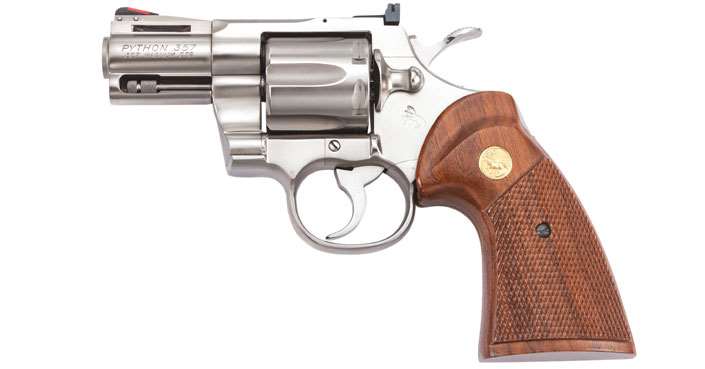
Commemorative issues and special editions were also based on the “I” frame. These include 1,780 guns built as part of the Colt Bicentennial Set in 1976. Factory special editions include the Double Diamond Set Python, the Snake Eyes Pythons and the Silver Snake Edition.
The Python was also popular with law enforcement agencies in special editions. Two hundred Special Edition revolvers were manufactured for the St. Paul Police Dept. in 1980, and another 200 for the Minneapolis Police Dept. in 1981. Also in 1981, 250 guns were built for the Durham County, N.C., Sheriff’s Dept., 235 Special Edition guns were built for the Colorado State Patrol in 1985 and 400 built for the Florida Highway Patrol Ass’n. Most of the police special editions had etched motifs on their frames, barrels and cylinders, and many of those editions had smooth, two-piece rosewood stocks with Colt Custom Shop medallions. They were normally offered with a walnut display case with French fitted interiors. Both medium blue and Tyrol Red interiors have been observed.
The Colorado State Patrol is also known to have issued Pythons as duty guns during the 1970s. These were blued guns with 4" ventilated-rib barrels and checkered walnut target stocks. The Florida Highway Patrol and Georgia State Patrol also issued Pythons to their troopers. It is also believed that 22 Pythons were built as part of the 150th Anniversary Engraving Sampler Series.
The April 1956 Colt catalog shows a suggested retail price of $125 for a blue Python, when the average weekly income for an American household that same year was $68. If you want to own one today, you need to have $2,000 or more in your pocket.
By 1998, the only cataloged Python was the Colt Custom Gun Shop Python Elite offered with a 6" barrel and a Brushed Stainless Steel finish. A year later, the Python Elite was catalogued in Royal Blue as well as Brushed Stainless Steel. By 2007, Colt’s Cadillac revolver, the beloved Python, had disappeared from the company catalog along with all of Colt’s other double-action revolvers. Fifty years had passed since its debut.
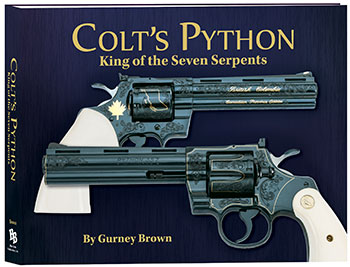 Colt’s Python: King Of The Seven Serpents
Colt’s Python: King Of The Seven Serpents
While Seven Serpents: The History of Colt’s Snake Guns (2015) brought much-needed information into the public eye on this previously underappreciated era and category of firearm collecting, Gurney Brown has broken new ground by narrowing his focus in Colt’s Python: King of the Seven Serpents. This tome leaves no stone unturned and leaves few, if any, unanswered questions about the fascinating history and production of one of the most heralded “snake” guns.
Here you will find 15 chapters, each dedicated to a specific Python collecting category. Every factory finish and configuration is covered, with detailed text and stunning right and left side photography of exceptional Pythons and the Colt factory letters that reflect how they were originally made in the Hartford factory between 1955 and 2006. The serial number information contained herein is published for the first time, and will instantly become a valued and essential reference for collectors, curators and historians.
The 304-pp. book contains 275 illustrations, costs $65 plus shipping and is available through Blue Book Publications, Inc., (800) 877-4867, bluebookofgunvalues.com.
—Philip Schreier, Senior Curator, NRA Museums












